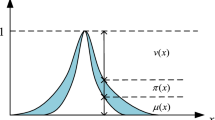Abstract
Many researches have been carried out in fuzzy linear regression the past three decades. However, almost all of them are limited to type-1 fuzzy data. A fuzzy linear regression model with type-2 fuzzy output data and type-2 fuzzy coefficients is studied in this paper. A linear programming model based on goal programming is proposed to calculate the regression coefficients. To evaluate the proposed model, we present some indices based on the standard deviation, the correlation coefficient, and the standard error of estimate. The proposed method is illustrated by some numerical examples.



Similar content being viewed by others
References
Celmins A (1987) Least squares model fitting to fuzzy vector data. Fuzzy Sets Syst 22:245–269
Charnes A, Cooper WW (1977) Goal programming and multiple objective optimizations. Eur J Oper Res 1:39–54
Coppi R, D’Urso P, Giordani P, Santoro A (2006) Least squares estimation of a linear regression model with LR fuzzy response. Comput Stat Data Anal 51:267–286
Diamond P (1988) Fuzzy least squares. Inf Sci 46:141–157
Donahue RL, Miller RW, Shickluna JC (1983) Soils, an introduction to soils and plant growth. Prentice-Hall, London
D’Urso P (2003) Linear regression analysis for fuzzy/crisp input and fuzzy/crisp output data. Comput Stat Data Anal 42:47–72
Hamrawi H, Coupland S (2009) Type-2 fuzzy arithmetic using alpha-planes. In: IFSA international congress on fuzzy systems, Portugal, pp 606–611
Hassanpour H, Maleki HR, Yaghoobi MA (2009) A goal programming approach to fuzzy linear regression with non-fuzzy input and fuzzy output data. Asia Pac J Oper Res 26(5):587–604
Hassanpour H, Maleki HR, Yaghoobi MA (2010) Fuzzy linear regression model with crisp coefficients: a goal programming approach. Iran J Fuzzy Syst 7(2):19–39
Hassanpour H, Maleki HR, Yaghoobi MA (2011) A goal programing approach to fuzzy linear regression with fuzzy input–output data. Soft Comput 15:1569–1580
Hisdal E (1981) The IF THEN ELSE statement and interval-valued fuzzy sets of higher type. Int J Man Mach Stud 15:385–455
Hojati M, Bector CR, Smimou K (2005) A simple method for computation of fuzzy linear regression. Eur J Oper Res 166:172–184
Hung WL, Yang MS (2006) An omission approach for detecting outliers in fuzzy regression models. Fuzzy Sets Syst 157:3109–3122
Kao C, Chyu CL (2003) Least-squares estimates in fuzzy regression analysis. EJOR 148:426–435
Kim B, Bishu RR (1998) Evaluation of fuzzy linear regression models by comparing membership functions. Fuzzy Sets Syst 100:343–352
Klir GJ, Sentz K (2006) Aspects of automatic text analysis. In: On the issue of linguistic approximation. Springer, New York
Maximal Software Inc. (2013) http://www.maximalsoftware.com. Accessed 5 Apr 2013
Mendel JM (1999) Computing with words when words can mean different things to different people. in: Presented at international ICSC congress on computational intelligence: methods and applications, 3rd annual symposium on fuzzy logic and applications, Rochester, p 2225
Ming M, Friedman M, Kandel A (1997) General fuzzy least-squares. Fuzzy Sets Syst 88:107–118
Modarres M, Nasrabadi E, Nasrabadi MM (2004) Fuzzy linear regression analysis from the point of view risk. Int J Uncertain Fuzziness Knowl Based Syst 12(5):635–649
Modarres M, Nasrabadi E, Nasrabadi MM (2005) Fuzzy linear regression models with least square errors. Appl Math Comput 163:977–989
Mohammadi J, Taheri SM (2004) Pedomodels fitting with fuzzy least squares regression. Iran J Fuzzy Syst 1(2):45–61
Özelkan EC, Duckstein L (2000) Multi-objective fuzzy regression: a general framework. Comput Oper Res 27:635–652
Peters G (1994) Fuzzy linear regression with fuzzy intervals. Fuzzy Sets Syst 63:45–55
Poleshchuk O, Komarov E (2008) Multiple hybrid regression for fuzzy observed data. In: Fuzzy information processing society (NAFIPS), pp 1–4
Poleshchuk O, Komarov E (2011) A nonlinear hybrid fuzzy least-squares regression model. In: Fuzzy information processing society (NAFIPS), pp 1–6
Poleshchuk O, Komarov E (2012) A fuzzy linear regression model for interval type-2 fuzzy sets. In: Fuzzy information processing society (NAFIPS), pp 1–5
Sakawa M, Yano H (1992) Multiobjective fuzzy linear regression analysis for fuzzy input–output data. Fuzzy Sets Syst 47:173–181
Sakawa M, Yano H (1992) Fuzzy linear regression and its applications. In: Kacprzyk J, Fedrizzi M (eds) Studies in fuzziness. Fuzzy regression analysis, vol 1. Omnitech Press, Warsaw, pp 61–80
Savic DA, Pedrycz W (1991) Evaluation of fuzzy linear regression models. Fuzzy SetsSyst 39:51–63
Schage L (1999) LINGO release 6.0. LINDO System Inc
Tanaka H, Uejima S, Asai K (1982) Linear regression analysis with fuzzy model. IEEE Trans Syst Man Cybren 12:903–907
Tanaka H (1987) Fuzzy data analysis by possibilistic linear models. Fuzzy Sets Syst 24:363–375
Tanaka H, Hayashi I, Watada J (1989) Possibilistic linear regression analysis for fuzzy data. Eur J Oper Res 40:389–396
Wünsche A, Näther W (2002) Least-squares fuzzy regression with fuzzy random variables. Fuzzy Sets Syst 130:43–50
Xu R, Li C (2001) Multidimensional least-squares fitting with a fuzzy model. Fuzzy Sets Syst 119:215–223
Yaghoobi MA, Tamiz M (2007) A method for solving fuzzy goal programming problems based on MINMAX approach. Eur J Oper Res 177(3):1580–1590
Yang MS, Ko CH (1996) On a class of fuzzy c-numbers clustering procedures for fuzzy data. Fuzzy sets Syst 84:49–60
Yang MS, Lin TS (2002) Fuzzy least squares linear regression analysis for fuzzy input-output data. Fuzzy Sets Syst 126:389–399
Zadeh LA (1975) Concept of a linguistic variable and its application to approximate reasoning-I. Inf Sci 8:199–249
Zadeh LA (1978) Fuzzy sets as a basis for a theory of possibility. Fuzzy Sets Syst 1:3–28
Author information
Authors and Affiliations
Corresponding author
Additional information
Communicated by V. Loia.
Rights and permissions
About this article
Cite this article
Hosseinzadeh, E., Hassanpour, H. & Arefi, M. A weighted goal programming approach to fuzzy linear regression with crisp inputs and type-2 fuzzy outputs. Soft Comput 19, 1143–1151 (2015). https://doi.org/10.1007/s00500-014-1328-3
Published:
Issue Date:
DOI: https://doi.org/10.1007/s00500-014-1328-3




